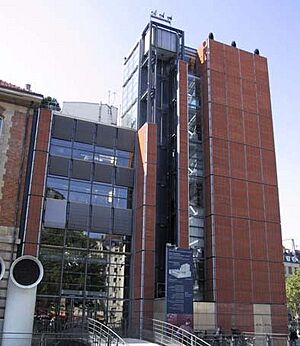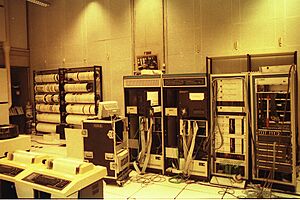IRCAM facts for kids
IRCAM stands for the Institute for Research and Coordination in Acoustics/Music. It is a special place in Paris, France, where people study music and sound. They focus on new and experimental music, especially music made with electronic sounds. IRCAM is connected to the famous Centre Pompidou art museum. Part of the building was designed by famous architects Renzo Piano and Richard Rogers. Much of IRCAM is actually built underground!
Contents
Exploring Music and Technology
IRCAM is a hub for new ideas in electronic music and sound processing. Many important tools and techniques for making music with computers were developed here.
Creating New Sounds
One big invention at IRCAM was FM synthesis. This is a way to create sounds using computers. It was pioneered by a researcher named John Chowning.
Another important tool is a computer program called Max. Miller Puckette first created Max at IRCAM in the 1980s. Today, a version called Max/MSP is widely used by musicians to make and control sounds in real-time.
Understanding Sound Deeply
Researchers at IRCAM also helped develop techniques for analyzing sound. This includes methods like fast Fourier transforms, which break down sounds into their basic parts. This helps composers understand and use the different elements of sound in their music. For example, they even created a special microphone for a cello. This microphone can pick up the sound from each of the cello's four strings separately. This allows for unique electronic effects on each string.
Visualizing Music
IRCAM has also helped create programs that show music visually. One example is OpenMusic. This is a special computer language that helps composers see and organize their musical ideas.
Training Future Composers
IRCAM offers classes to teach composers how to use music technology. If a composer doesn't know how to program, IRCAM provides an assistant. This assistant helps them bring their musical ideas to life using computers and electronics. This support helps composers create complex pieces that combine traditional instruments with new technology.
A Place for Modern Music
Besides electronic music, IRCAM also supports modern classical music. It has helped share the works of important composers like Luciano Berio and Pierre Boulez. It also supports younger musicians and composers.
Supporting New Musical Styles
A style of music called "spectralism" has also been supported by IRCAM. This style focuses on the natural properties of sound. Composers like Tristan Murail and Kaija Saariaho, whose music is influenced by spectralism, have worked at IRCAM.
Innovative Performances
IRCAM has also helped create new ways to perform music. The Ensemble InterContemporain is a group of musicians who specialize in modern classical music. They are based at IRCAM. This group has inspired many other music ensembles in Europe. Many new classical pieces have been written for them. IRCAM also hosts regular concerts for the public.
IRCAM's Story
In 1970, the French President Georges Pompidou asked composer Pierre Boulez to start a music research center. The building was finished in 1973, and IRCAM officially opened in 1977. Pierre Boulez was the first director.
Leaders of IRCAM
Over the years, IRCAM has had several leaders:
- 1977-1992: Pierre Boulez
- 1992-2002: Laurent Bayle
- 2002-2006: Bernard Stiegler
- 2006-Present: Frank Madlener
Digital Library
In 1996, IRCAM opened its multimedia library. It was one of the first music libraries to combine physical books and sheet music with digital resources. It has thousands of hours of recorded music and many scientific articles available online.
Important Conferences
IRCAM has hosted several international conferences where experts discuss music and technology:
- 1984: The International Computer Music Conference (ICMC)
- 2002: The 3rd International Conference on Music Information Retrieval (ISMIR)
- 2006: The 6th International Conference on New Interfaces for Musical Expression (NIME-06)
- Since 2012: Acanthes, a yearly summer festival and workshops for composers.
Research and Development
IRCAM has many teams working on different areas of music and sound research.
Research Areas
- How instruments make sound (Instrumental acoustics)
- How sound behaves in rooms (Room acoustics)
- Using music for healing (Music therapy)
- How we hear and understand music (Musical perception and cognition)
- Analyzing and creating sounds (Analysis/synthesis)
- Ways to represent music (Music representations)
- Creating free software for music (Free software and software engineering)
- Designing sounds (Sound design)
- Online services for music.
Software Made at IRCAM
IRCAM develops many useful software tools for musicians and researchers. Some of these include:
- OpenMusic: A visual programming language for music composition.
- AudioSculpt: For analyzing and transforming sounds.
- OMax: For interactive music performance.
- Spat: For controlling sound in 3D space.
- Modalys: For physical modeling synthesis (creating sounds by simulating how objects vibrate).
- Antescofo: For following a live musician's performance and synchronizing it with electronic sounds.
- Orchidée: A tool that helps composers choose instruments for an orchestra. It can suggest combinations of instruments that sound like a target sound. For example, it was used in Jonathan Harvey's piece "Speakings" to imitate speech patterns.
IRCAM shares its software through a special membership program called the IRCAM Forum. Members meet yearly for workshops on new technologies. IRCAM also created its own music file format, `.sf`.
Recently, IRCAM has been working on artificial intelligence for music. They developed RAVE (Realtime Audio Variational autoEncoder). This is a learning system that can create high-quality audio sounds very quickly. It can be used for making new sounds or changing existing ones in real-time.
IRCAM also works with companies like Cycling 74 (who make Max/MSP) and Flux:: (who make IRCAM Tools) to develop other software.
Notable Music Created at IRCAM
Many famous pieces of music have been created or developed at IRCAM. Here are some examples:
- Georges Aperghis: Machinations (2000)
- George Benjamin: Antara (1986–87)
- Luciano Berio: Chemins ex V (1980)
- Harrison Birtwistle: The Mask of Orpheus (1986)
- Pierre Boulez: Anthèmes II (1997)
- Pierre Boulez: Dialogue de l'ombre double (1985)
- Pierre Boulez: ...explosante-fixe... (1993)
- Pierre Boulez: Répons (1981–1984)
- John Cage: Roaratorio (1980)
- John Chowning: Stria (1977)
- Chaya Czernowin: "Hidden" (2014)
- Pascal Dusapin: To Be Sung (1992–93)
- Jonathan Harvey: Advaya (1994)
- Jonathan Harvey: Mortuos Plango, Vivos Voco (1980)
- Jonathan Harvey: Speakings (2008)
- York Höller: The Master and Margarita (1989)
- Magnus Lindberg: Joy
- Tod Machover: VALIS (1986–87/1988)
- Philippe Manoury: Jupiter
- Tristan Murail: L'Esprit des dunes (1993–1994)
- Kaija Saariaho: Lonh (1995–96)
- Kaija Saariaho: NoaNoa (1992)
- Karlheinz Stockhausen: Kathinkas Gesang als Luzifers Requiem (1985)
- Iannis Xenakis: Psappha (1976/1996)
- Frank Zappa: Perfect Stranger (1984)
Partnerships
IRCAM works with other important research centers around the world. These include the Center for Computer Research and Acoustics (CCRMA) at Stanford University. They also partner with the Center for New Music and Audio Technologies (CNMAT) in Berkeley, California.
See also
 In Spanish: Institut de Recherche et Coordination Acoustique/Musique para niños
In Spanish: Institut de Recherche et Coordination Acoustique/Musique para niños
- List of music software



